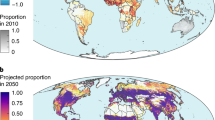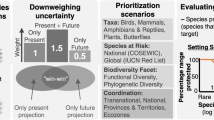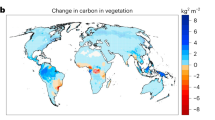Abstract
Global biodiversity is rapidly declining, and goals to halt biodiversity loss, such as the Aichi Biodiversity Targets, have not been achieved. To avoid further biodiversity loss, area-based protection will form part of new biodiversity targets. We use a state-of-the-art global land-use model, the Land System Modular Model, to explore global and regional human health and food security outcomes under strictly enforced 30% and 50% land protection scenarios. We find protection scenarios cause additional human mortality due to diet- and weight-related changes. Low-income regions such as South Asia and sub-Saharan Africa experience the highest levels of underweight-related mortality, causing an additional 200,000 deaths related to malnutrition in these regions alone. High-income regions, by contrast, are less affected by protection measures. Our results highlight that radical measures to protect areas of biodiversity value may jeopardize food security and human health in the most vulnerable regions of the world.
This is a preview of subscription content, access via your institution
Access options
Access Nature and 54 other Nature Portfolio journals
Get Nature+, our best-value online-access subscription
$29.99 / 30 days
cancel any time
Subscribe to this journal
Receive 12 digital issues and online access to articles
$119.00 per year
only $9.92 per issue
Buy this article
- Purchase on Springer Link
- Instant access to full article PDF
Prices may be subject to local taxes which are calculated during checkout



Similar content being viewed by others
Data availability
The LandSyMM output data used in this study are available through Zenodo (https://doi.org/10.5281/zenodo.5749706). Food consumption data were accessed through FAOSTAT (https://www.fao.org/faostat/en/);. BMI data were accessed through the WHO global health observatory database (https://www.who.int/gho/database/en/). Disease and mortality data were accessed through the global health data exchange (http://ghdx.healthdata.org/gbd-results-tool).
Code availability
LandSyMM model code is available on request from the authors.
References
Butchart, S. H. M. et al. Global biodiversity: indicators of recent declines. Science 328, 1164–1168 (2010).
Buchanan, G. M., Butchart, S. H. M., Chandler, G. & Gregory, R. D. Assessment of national-level progress towards elements of the Aichi Biodiversity Targets. Ecol. Indic. 116, 106497 (2020).
Butchart, S. H. M. et al. in Global Assessment Report of the Intergovernmental Science–Policy Platform on Biodiversity and Ecosystem Services (eds Berkes, F. & Brooks, T. M.) Ch. 3 (IPBES Secretariat, 2019); https://doi.org/10.5281/zenodo.3832053
Maxwell, S. L. et al. Area-based conservation in the twenty-first century. Nature 586, 217–227 (2020).
Locke, H. Nature needs half: a necessary and hopeful new agenda for protected areas. Nat. N. S. W. 58, 7–17 (2014).
Dinerstein, E. et al. An ecoregion-based approach to protecting half the terrestrial realm. Bioscience 67, 534–545 (2017).
Dinerstein, E. et al. A global deal for nature: guiding principles, milestones, and targets. Sci. Adv. 5, eaaw2869 (2019).
Mehrabi, Z., Ellis, E. C. & Ramankutty, N. The challenge of feeding the world while conserving half the planet. Nat. Sustain. 1, 409–412 (2018).
Kok, M. T. J. et al. Assessing ambitious nature conservation strategies within a 2 degree warmer and food-secure world. Preprint at bioRxiv https://doi.org/10.1101/2020.08.04.236489 (2020).
Rosa, I. M. D. et al. Multiscale scenarios for nature futures. Nat. Ecol. Evol. 1, 1416–1419 (2017).
Obermeister, N. Local knowledge, global ambitions: IPBES and the advent of multi-scale models and scenarios. Sustain. Sci. 14, 843–856 (2019).
Pereira, L. M. et al. Developing multiscale and integrative nature–people scenarios using the Nature Futures Framework. People Nat. 2, 1172–1195 (2020).
Rabin, S. S. et al. Impacts of future agricultural change on ecosystem service indicators. Earth Syst. Dynam. 11, 357–376 (2019).
Springmann, M. et al. Global and regional health effects of future food production under climate change: a modelling study. Lancet 387, 1937–1946 (2016).
Springmann, M. et al. Health and nutritional aspects of sustainable diet strategies and their association with environmental impacts: a global modelling analysis with country-level detail. Lancet Planet. Health 2, e451–e461 (2018).
Dinerstein, E. et al. A “Global Safety Net” to reverse biodiversity loss and stabilize Earth’s climate. Sci. Adv. 6, eabb2824 (2020).
Locke, H. et al. Three global conditions for biodiversity conservation and sustainable use: an implementation framework. Natl Sci. Rev. https://doi.org/10.1093/nsr/nwz136 (2019).
Waldron, A. et al. Protecting 30% of the Planet for Nature: Costs, Benefits and Economic Implications (Campaign for Nature, 2020).
Strassburg, B. B. N. et al. Global priority areas for ecosystem restoration. Nature 586, 724–729 (2020).
O’Neill, B. C. et al. The roads ahead: narratives for Shared Socioeconomic Pathways describing world futures in the 21st century. Glob. Environ. Change 42, 169–180 (2015).
Riahi, K. et al. The Shared Socioeconomic Pathways and their energy, land use, and greenhouse gas emissions implications: an overview. Glob. Environ. Change 42, 153–168 (2017).
Tauli-Corpuz, V., Alcorn, J., Molnar, A., Healy, C. & Barrow, E. Cornered by PAs: adopting rights-based approaches to enable cost-effective conservation and climate action. World Dev. 130, 104923 (2020).
Kashwan, P. V., Duffy, R., Massé, F., Asiyanbi, A. P. & Marijnen, E. From racialized neocolonial global conservation to an inclusive and regenerative conservation. Environ. Sci. Policy Sustain. Dev. 63, 4–19 (2021).
The State of Food Security and Nutrition in the World 2017: Building Resilience for Peace and Food Security (FAO, 2017).
Schleicher, J. et al. Protecting half of the planet could directly affect over one billion people. Nat. Sustain. 2, 1094–1096 (2019).
Allan, J. R. et al. The minimum land area requiring conservation attention to safeguard biodiversity. Preprint at bioRxiv https://doi.org/10.1101/839977 (2021).
Brockington, D. & Wilkie, D. Protected areas and poverty. Phil. Trans. R. Soc. B 370, 20140271 (2015).
Protected Planet Report 2020 (UNEP–WCMC and IUCN, 2021).
Naidoo, R. et al. Evaluating the impacts of protected areas on human well-being across the developing world. Sci. Adv. 5, eaav3006 (2019).
Dutta, A., Allan, J., Shimray, G., General, S. & Pact, A. I. P. RE: “A ‘Global Safety Net’ to reverse biodiversity loss and stabilize Earth’s climate”. Sci. Adv. 6, eabb2824 (2020).
Simmons, B. A., Nolte, C. & McGowan, J. Tough questions for the “30 × 30” conservation agenda. Front. Ecol. Environ. 19, 322–323 (2021).
Jung, M. et al. Areas of global importance for conserving terrestrial biodiversity, carbon and water. Nat. Ecol. Evol. https://doi.org/10.1038/s41559-021-01528-7 (2021).
The IUCN Red List of Threatened Species Version 2019.2 (IUCN, 2019).
The World Database of Key Biodiversity Areas (KBA Partnership, 2019); www.keybiodiversityareas.org
Mogg, S., Fastre, C. & Visconti, P. Targeted expansion of protected areas to maximise the persistence of terrestrial mammals. Preprint at bioRxiv https://doi.org/10.1101/608992 (2019).
Gurobi Optimizer Reference Manual (Gurobi Optimization, 2019).
Hanson, J. O. et al. prioritizr: Systematic Conservation Prioritization in R. R package version 5.0.3 https://CRAN.R-project.org/package=prioritizr (2020).
Hurtt, G., Chini, L., Frolking, S. & Sahajpal, R. Land-Use Harmonization (LUH2) (Global Ecology Laboratory, Univ. Maryland, 2017).
Protected Planet: The World Database on Protected Areas (WDPA) (UNEP-WCMC and IUCN, accessed April 2019); www.protectedplanet.net
Dellink, R., Chateau, J., Lanzi, E. & Magné, B. Long-term economic growth projections in the Shared Socioeconomic Pathways. Glob. Environ. Change 42, 200–214 (2017).
Jones, B. & O’Neill, B. C. Spatially explicit global population scenarios consistent with the Shared Socioeconomic Pathways. Environ. Res. Lett. 11, 84003 (2016).
van Vuuren, D. P. et al. The representative concentration pathways: an overview. Climatic Change 109, 5–31 (2011).
Engström, K. et al. Assessing uncertainties in global cropland futures using a conditional probabilistic modelling framework. Earth Syst. Dynam. 7, 893–915 (2016).
Alexander, P. et al. Drivers for global agricultural land use change: the nexus of diet, population, yield and bioenergy. Glob. Environ. Change 35, 138–147 (2015).
Popp, A. et al. Land-use transition for bioenergy and climate stabilization: model comparison of drivers, impacts and interactions with other land use based mitigation options. Climatic Change 123, 495–509 (2014).
GBD Results Tool (IHME, 2020); http://ghdx.healthdata.org/gbd-results-tool
KC, S. & Lutz, W. The human core of the Shared Socioeconomic Pathways: population scenarios by age, sex and level of education for all countries to 2100. Glob. Environ. Change 42, 181–192 (2017).
Acknowledgements
R.C.H., F.W. and P.A. were supported by the UK’s Global Food Security Programme project Resilience of the UK food system to Global Shocks (RUGS, BB/N020707/1). M.J. acknowledges funding from the Nature Map project through Norway’s International Climate and Forest Initiative (NICFI). A.A. and M.D.R. acknowledge support through the Helmholtz Association. S.S.R. acknowledges support by the BMBF Germany/ISIPEDIA project. We thank P. Visconti for cross reading the manuscript and contributing to the discussion of the results.
Author information
Authors and Affiliations
Contributions
R.C.H., A.A., P.A. and M.D.R. developed the idea. R.C.H., F.W., S.S.R. and M.J. contributed to method development and data analysis. R.C.H. wrote the manuscript and all authors contributed to editing and reviewing the manuscript and approved the final version for submission and publication.
Corresponding author
Ethics declarations
Competing interests
The authors declare no competing interests.
Peer review
Peer review information
Nature Sustainability thanks Dan Brockington, Julie Zaehringer and the other, anonymous, reviewer(s) for their contribution to the peer review of this work.
Additional information
Publisher’s note Springer Nature remains neutral with regard to jurisdictional claims in published maps and institutional affiliations.
Supplementary information
Supplementary Information
Supplementary Methods, Results, Figs. 1–7 and Tables 1–6.
Rights and permissions
About this article
Cite this article
Henry, R.C., Arneth, A., Jung, M. et al. Global and regional health and food security under strict conservation scenarios. Nat Sustain 5, 303–310 (2022). https://doi.org/10.1038/s41893-021-00844-x
Received:
Accepted:
Published:
Issue Date:
DOI: https://doi.org/10.1038/s41893-021-00844-x
This article is cited by
-
Optimization of land use planning under multi-objective demand—the case of Changchun City, China
Environmental Science and Pollution Research (2024)
-
Analysing the distribution of strictly protected areas toward the EU2030 target
Biodiversity and Conservation (2023)
-
Mapping the shared socio-economic pathways onto the Nature Futures Framework at the global scale
Sustainability Science (2023)
-
High energy and fertilizer prices are more damaging than food export curtailment from Ukraine and Russia for food prices, health and the environment
Nature Food (2022)



